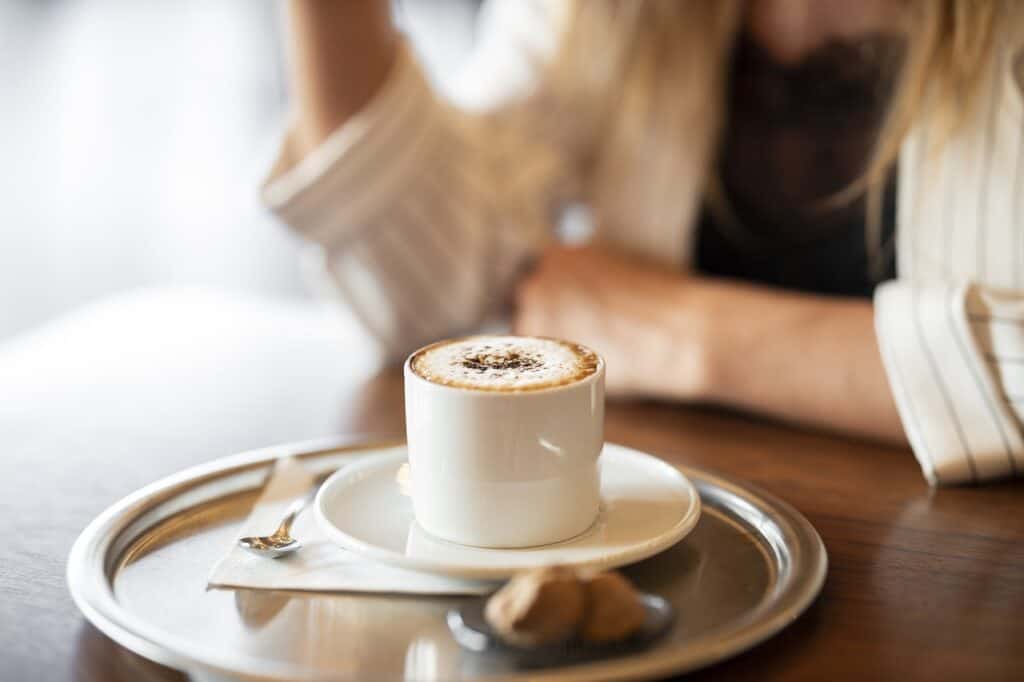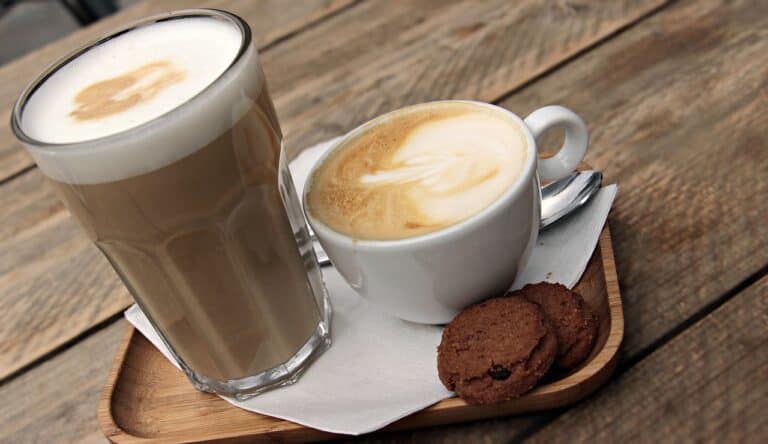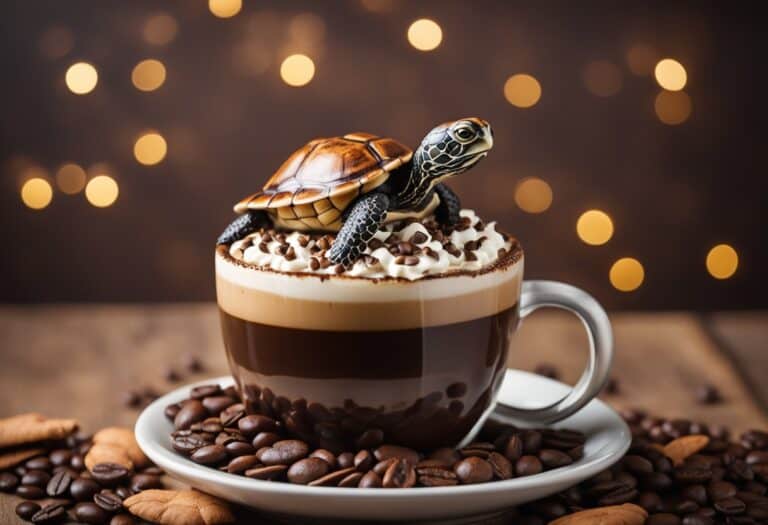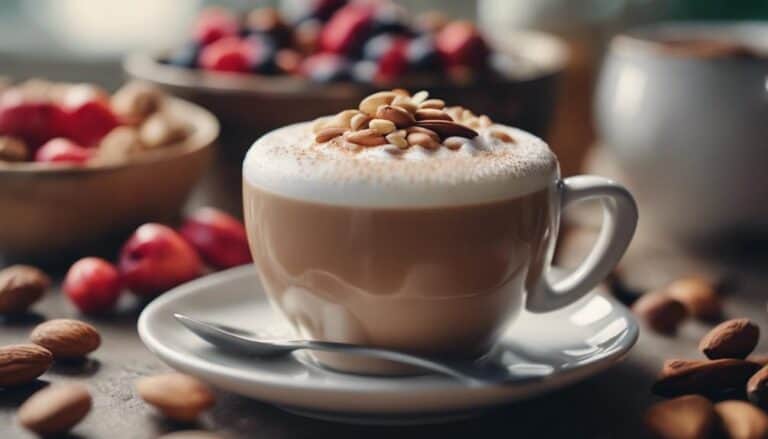Latte Versus Cappuccino: Understanding the Key Differences

Latte and cappuccino are two of the most popular coffee drinks in the world. They are both espresso-based drinks that are widely consumed in cafes and restaurants. Although they share some similarities, they are quite different in terms of texture, flavor, and preparation.
In this article, we will explore the differences between latte and cappuccino, their origins, ingredients, and preparation methods, and help you choose between the two.
Understanding the basics of latte and cappuccino is essential to appreciate the differences between the two. A latte is a coffee drink made with espresso and steamed milk, topped with a thin layer of frothed milk.
A cappuccino, on the other hand, is made with equal parts of espresso, steamed milk, and frothed milk. The frothed milk in a cappuccino is thicker and denser than that in a latte, which makes it more suitable for latte art. The proportions of espresso, milk, and foam in a cappuccino are carefully balanced to create a rich, creamy texture and a bold flavor.
Understanding the Basics
What is a Latte?
A latte is a popular coffee drink made with espresso and steamed milk. The word “latte” comes from the Italian word “caffè latte,” which means “milk coffee.” A latte typically consists of one or two shots of espresso, steamed milk, and a small layer of foam on top. The ratio of espresso to milk can vary, but it is typically around 1:3 or 1:4.
The steamed milk in a latte creates a smooth and creamy texture, while the foam adds a light and airy layer on top. The foam is created by aerating the milk with steam, which adds air bubbles and increases the volume of the milk. The foam can be used to create latte art, which is a popular trend among baristas.
What is a Cappuccino?
A cappuccino is another popular coffee drink made with espresso and steamed milk, but it has a different ratio of ingredients than a latte. A cappuccino typically consists of one or two shots of espresso, steamed milk, and a layer of foam on top. The ratio of espresso to milk to foam is usually 1:1:1.
The foam in a cappuccino is thicker than in a latte and has a velvety texture. The foam is created by steaming the milk to a higher temperature than in a latte, which creates more bubbles and a thicker consistency. The result is a drink with a strong espresso flavor and a creamy, frothy texture.
Espresso
Both lattes and cappuccinos are made with espresso, which is a concentrated coffee drink made by forcing hot water through finely ground coffee beans. Espresso has a strong, bold flavor and a thick, creamy texture. It is the foundation of many coffee drinks, including lattes and cappuccinos.
Milk
Milk is a key ingredient in both lattes and cappuccinos. The milk is steamed to create a smooth and creamy texture and to add a layer of foam on top. The type of milk used can vary, but whole milk is the most common choice. Some people prefer to use non-dairy milk, such as soy or almond milk, for a dairy-free option.
Steamed Milk
Steamed milk is an important component of both lattes and cappuccinos. The milk is heated and aerated with steam, which creates a smooth and creamy texture. The temperature of the milk is important, as it can affect the flavor and texture of the drink. The milk should be heated to around 150-155°F for lattes and around 140-150°F for cappuccinos.
Foam
Foam is a key element in both lattes and cappuccinos. The foam is created by aerating the milk with steam, which adds air bubbles and increases the volume of the milk. The foam in a latte is typically lighter and airier than in a cappuccino, which has a thicker and creamier foam. The foam can be used to create latte art, which is a popular trend among baristas.

The Italian Origin
When it comes to coffee, Italy is often considered the birthplace of many popular coffee drinks. Both latte and cappuccino have their roots in Italian coffee culture and have become popular around the world.
Latte in Italy
In Italy, a latte is not the same as the latte you might order at a coffee shop in the United States. In fact, ordering a “latte” in Italy will likely result in a glass of milk, as “latte” simply means milk in Italian. If you want a latte in Italy, you would need to order a “caffè latte,” which is a shot of espresso mixed with hot milk.
Caffè latte is typically served in a large cup or bowl and is a popular breakfast drink in Italy. It’s not uncommon for Italians to make their own caffè latte at home using a moka pot, which is a stovetop espresso maker.
Cappuccino in Italy
Like the latte, the cappuccino also has its origins in Italy. The word “cappuccino” actually comes from the Capuchin friars, a religious order of friars in the Catholic Church. The brown hooded robes worn by the Capuchin friars were said to resemble the color of the coffee and milk mixture in a cappuccino.
In Italy, cappuccinos are typically consumed in the morning and are not typically ordered after a meal. It’s also important to note that ordering a cappuccino after 11 a.m. in Italy is considered a faux pas, as it’s believed that the milk in the drink can interfere with digestion.
Overall, both latte and cappuccino have their roots in Italian coffee culture and have become popular around the world. While the drinks may have different meanings and traditions in Italy compared to other countries, they both remain beloved staples of Italian coffee culture.
Ingredients and Preparation
When it comes to the ingredients and preparation of latte and cappuccino, there are some significant differences to note. Both drinks are made with espresso shots, but the milk and foam ratios vary, resulting in different tastes and textures.
Latte Ingredients and Preparation
A latte is made with one shot of espresso, steamed milk, and a thin layer of milk foam on top. The ratio of milk to espresso is typically 2:1, which creates a creamier and milkier taste. The milk used can be any type, including whole milk, skim milk, or non-dairy milk alternatives. The steamed milk is poured over the espresso shot, and a thin layer of milk foam is added on top.
To prepare a latte, the espresso shot is pulled first, and then the milk is steamed and frothed to create a creamy texture. The steamed milk is poured into the cup, followed by the espresso shot, and then the milk foam is added on top. This results in a smooth, creamy texture with a milder coffee taste.
Cappuccino Ingredients and Preparation
Cappuccino is made with equal parts espresso, steamed milk, and milk foam. The espresso shot is pulled first, and then the steamed milk is added to create a creamy texture. The milk foam is added on top, creating a thick layer of foam that sits on top of the drink.
To prepare a cappuccino, the barista pulls an espresso shot and steams the milk to create a creamy texture. The steamed milk is then poured into the cup, followed by the espresso shot. Finally, the milk foam is added on top, creating a distinct layer of foam.
The main difference between latte and cappuccino is the milk and foam ratios. A cappuccino has a stronger coffee taste due to the equal parts of espresso and steamed milk, and the thick layer of foam on top. In contrast, a latte has a creamier texture due to the higher ratio of steamed milk to espresso, and the thin layer of milk foam on top.
Texture and Flavor
When it comes to coffee, texture and flavor are two crucial aspects that can make or break the experience. In this section, we’ll explore the texture and flavor of lattes and cappuccinos.
Latte Texture and Flavor
Lattes have a smooth and creamy texture, with a thin layer of foam on top. The steamed milk in a latte is mixed with the espresso, creating a velvety texture that’s easy to drink. The milk in a latte is steamed to a higher temperature than in a cappuccino, which gives it a slightly sweeter taste. Lattes are generally considered to have a milder coffee flavor than cappuccinos, as they contain a greater proportion of steamed milk.
Cappuccino Texture and Flavor
Cappuccinos, on the other hand, have a drier texture and a stronger coffee flavor than lattes. Cappuccinos are made with less milk and more foam than lattes, giving them a thicker texture. A well-made cappuccino will have a 1-to-1 ratio of liquid to foam, which experts can determine based on the drink’s weight. The milk in a cappuccino is steamed to a lower temperature than in a latte, which gives it a stronger coffee flavor. Cappuccinos are generally considered to be a more intense coffee experience than lattes.
Overall, the texture and flavor of lattes and cappuccinos are quite different. Lattes are smooth and creamy, with a mild coffee flavor, while cappuccinos are drier and stronger. The choice between the two ultimately comes down to personal preference. If you prefer a milder coffee experience, a latte might be the way to go. If you’re looking for a more intense coffee flavor, a cappuccino might be the better choice.
Size and Proportions
Size and Proportions of a Latte
Lattes are typically larger in size than cappuccinos, with a standard serving size of 8-12 ounces. The size of a latte can vary depending on where you order it, but it is usually served in a tall glass or cup. The proportions of a latte are typically 1/3 espresso, 2/3 steamed milk, and a small amount of foam on top. The ratio of espresso to milk can be adjusted to taste, with some people preferring a stronger coffee flavor and others preferring a creamier taste.
Size and Proportions of a Cappuccino
Cappuccinos are smaller in size than lattes, with a standard serving size of 5-6 ounces. The size of a cappuccino is designed to fit perfectly in a small cup, with a layer of foam on top. The proportions of a cappuccino are typically equal parts espresso, steamed milk, and foam. The ratio of espresso to milk can also be adjusted to taste, but the foam is a crucial component of a cappuccino and should not be omitted.
When it comes to the size and proportions of a latte versus a cappuccino, it ultimately comes down to personal preference. If you prefer a larger drink with a creamier taste, a latte may be the right choice for you. If you prefer a smaller drink with a stronger coffee flavor and a layer of foam on top, a cappuccino may be the way to go. It is important to note that the size and proportions can vary depending on where you order your drink, so be sure to ask your barista for their specific recipe.
In summary, lattes are typically larger in size with a ratio of 1/3 espresso to 2/3 steamed milk, while cappuccinos are smaller in size with equal parts espresso, steamed milk, and foam.
Variations
When it comes to coffee, there are a variety of ways to customize your drink to your personal preferences. Lattes and cappuccinos are no exception. Here are some of the most popular variations of these classic espresso drinks:
Latte Variations
- Café Latte: This is the classic latte, made with espresso and steamed milk, and topped with a small layer of foam. Some cafes may add a shot of flavor syrup to create a flavored latte, such as vanilla or caramel.
- Mocha Latte: A mocha latte is a latte with chocolate syrup added. This creates a rich, chocolatey flavor that is perfect for those with a sweet tooth.
- Iced Latte: An iced latte is simply a latte that is served over ice. This is a great option for those who prefer a cold, refreshing drink.
Cappuccino Variations
- Dry Cappuccino: A dry cappuccino is a cappuccino with less steamed milk and more foam. This creates a drier, more textured drink that is perfect for those who prefer a stronger espresso flavor.
- Wet Cappuccino: A wet cappuccino is a cappuccino with more steamed milk and less foam. This creates a creamier, smoother drink that is perfect for those who prefer a milder espresso flavor.
- Flat White: A flat white is similar to a cappuccino, but with less foam and a higher ratio of espresso to milk. This creates a stronger, more concentrated drink that is perfect for those who prefer a bolder espresso flavor.
- Americano: An americano is a shot of espresso diluted with hot water. This creates a milder, less concentrated drink that is perfect for those who prefer a less intense espresso flavor.
As you can see, there are many ways to customize your latte or cappuccino to your personal taste. Whether you prefer a sweet, chocolatey drink or a strong, bold espresso flavor, there is a variation out there for you.
Health and Nutrition
Health Benefits and Considerations of a Latte
Lattes are a popular coffee drink that consist of espresso and steamed milk. Here are some health benefits and considerations of lattes:
- Caffeine: A typical latte contains one or two shots of espresso, which has about 63mg of caffeine per shot. This amount of caffeine is lower than a regular cup of coffee, which has about 95mg of caffeine per cup. If you are sensitive to caffeine, a latte may be a good option for you.
- Calories: A 12-ounce latte made with whole milk contains about 210 calories. If you are watching your calorie intake, you may want to opt for a smaller size or a non-fat milk option.
- Fat: Lattes made with whole milk contain about 9g of fat per 12-ounce serving. If you are looking to reduce your fat intake, you may want to opt for a non-fat milk option instead.
- Sugar: Lattes can be high in sugar, especially if you add flavored syrups. A 12-ounce latte made with whole milk and flavored syrup can contain up to 25g of sugar. If you are trying to reduce your sugar intake, you may want to opt for a plain latte or use sugar-free syrups.
Health Benefits and Considerations of a Cappuccino
Cappuccinos are another popular coffee drink that consist of espresso, steamed milk, and milk foam. Here are some health benefits and considerations of cappuccinos:
- Caffeine: Like lattes, cappuccinos contain one or two shots of espresso, which has about 63mg of caffeine per shot. If you are sensitive to caffeine, a cappuccino may be a good option for you.
- Calories: A 12-ounce cappuccino made with whole milk contains about 130 calories, which is lower than a latte. If you are watching your calorie intake, a cappuccino may be a good option for you.
- Fat: Cappuccinos made with whole milk contain about 6g of fat per 12-ounce serving, which is lower than a latte. If you are looking to reduce your fat intake, a cappuccino may be a good option for you.
- Sugar: Cappuccinos are generally lower in sugar than lattes because they do not contain flavored syrups. A 12-ounce cappuccino made with whole milk contains about 7g of sugar. If you are trying to reduce your sugar intake, a cappuccino may be a good option for you.
Overall, lattes and cappuccinos can be part of a healthy and balanced diet, but it is important to be mindful of your calorie, fat, and sugar intake. Opting for non-fat milk and sugar-free syrups can help reduce the calorie and sugar content of these drinks.
Latte and Cappuccino Art
Latte and cappuccino art is a popular way for baristas to showcase their skills and creativity. It involves creating designs on the surface of the drink using the microfoam, which is a velvety and creamy texture created by steaming milk.
Latte art typically involves creating designs such as hearts, rosettas, and tulips, while cappuccino art often involves creating more intricate designs such as swans and bears. These designs are created by pouring the microfoam into the espresso shot in a specific way and using a tool such as a toothpick to manipulate the foam.
Baristas who specialize in latte and cappuccino art spend a lot of time perfecting their craft. They need to have a deep understanding of the milk steaming process and how to create the perfect microfoam. They also need to have a steady hand and be able to pour the milk in a precise manner to create the desired design.
Latte and cappuccino art has become so popular that there are now competitions held around the world for baristas to showcase their skills. These competitions often involve creating complex designs and require a high level of skill and creativity.
Overall, latte and cappuccino art is a fun and creative way for baristas to showcase their skills and add a personal touch to each drink they make. It takes a lot of practice and dedication to perfect, but the end result is a beautiful and delicious drink that customers can enjoy.

Making Lattes and Cappuccinos at Home
If you’re a fan of lattes and cappuccinos and want to enjoy them from the comfort of your home, you’re in luck! With a few pieces of equipment and some simple steps, you can easily make these delicious drinks in your own kitchen.
Equipment Needed
To make lattes and cappuccinos at home, you’ll need the following equipment:
- Espresso machine (with a steaming wand)
- Milk jug
- Whisk
- Coffee beans
- Grinder
- Tamper
- Cups
Steps to Make a Latte at Home
- Grind your coffee beans and tamp them into the portafilter.
- Brew a shot of espresso using your espresso machine.
- Pour cold milk into a milk jug and place it under the steaming wand.
- Turn on the steaming wand and steam the milk until it reaches the desired temperature.
- Use a whisk to froth the milk until it becomes creamy and smooth.
- Pour the frothed milk into the espresso shot.
- Use a spoon to hold back the froth and pour the remaining milk into the coffee.
- Add any desired flavorings, such as vanilla or caramel syrup.
Steps to Make a Cappuccino at Home
- Grind your coffee beans and tamp them into the portafilter.
- Brew a shot of espresso using your espresso machine.
- Pour cold milk into a milk jug and place it under the steaming wand.
- Turn on the steaming wand and steam the milk until it reaches the desired temperature.
- Use a whisk to froth the milk until it becomes creamy and smooth.
- Pour the frothed milk into the espresso shot.
- Spoon the froth on top of the coffee.
- Add any desired flavorings, such as chocolate powder or cinnamon.
By following these simple steps, you can enjoy a delicious latte or cappuccino at home anytime you want. With a little practice, you’ll be able to make these drinks just as well as your favorite coffee shop.
Choosing Between a Latte and a Cappuccino
When it comes to choosing between a latte and a cappuccino, it ultimately comes down to personal preference and the cafe experience you are looking for. Here are some factors to consider:
Personal Preference
Latte and cappuccino have different milk-to-coffee ratios, which affects the overall taste and texture of the drink. A latte has more milk and less foam, resulting in a creamier and smoother taste. On the other hand, a cappuccino has less milk and more foam, resulting in a stronger and more textured taste.
If you prefer a stronger coffee taste, then a cappuccino may be the better choice for you. However, if you prefer a creamier and smoother taste, then a latte may be the better choice. Additionally, you can customize your drink by choosing alternative milks such as oat milk or adding syrups to your drink.
Cafe Experience
The cafe experience can also influence your choice between a latte and a cappuccino. Some cafes may specialize in one drink over the other, and some may offer different variations of the drinks.
If you enjoy a milk foam layer on top of your coffee, then a cappuccino may be the better choice for you. However, if you prefer frothed milk mixed with your coffee, then a latte may be the better choice. Additionally, some cafes may offer latte art, which is a design made with textured milk on top of your latte.
Overall, it’s important to consider your personal taste preferences and the cafe experience when choosing between a latte and a cappuccino. Keep in mind that both drinks use espresso and textured milk, which are key components in creating a delicious and satisfying drink.
Frequently Asked Questions
What is the difference between a latte, cappuccino, and macchiato?
A latte is made with espresso and steamed milk, topped with a thin layer of foam. A cappuccino is made with equal parts of espresso, steamed milk, and foam, while a macchiato is a shot of espresso with a small amount of foamed milk on top.
Which is sweeter, a cappuccino or latte?
Neither drink is inherently sweeter, as the sweetness depends on the amount of sugar or syrup added. However, a latte may taste slightly sweeter due to the higher milk content.
What is healthier, a latte or cappuccino?
Both drinks can be part of a healthy diet when consumed in moderation. However, a cappuccino may be slightly healthier due to its lower milk content.
What are the calories in a latte versus cappuccino?
The number of calories in a latte or cappuccino depends on the size and type of milk used. Generally, a 12-ounce latte made with whole milk contains around 210 calories, while a 12-ounce cappuccino made with whole milk contains around 130 calories.
How do the taste profiles of latte and cappuccino differ?
A latte has a milder taste due to the higher milk content, while a cappuccino has a stronger espresso flavor due to the equal parts of espresso and milk.
What is the difference between cappuccino and flat white?
A cappuccino has equal parts of espresso, steamed milk, and foam, while a flat white has a higher espresso to milk ratio and a thinner layer of microfoam.





